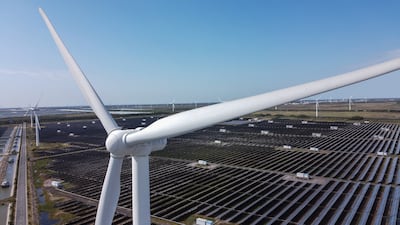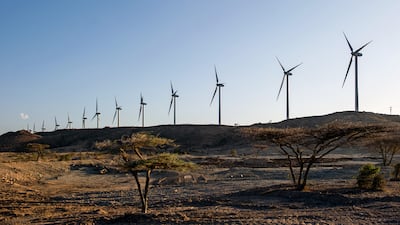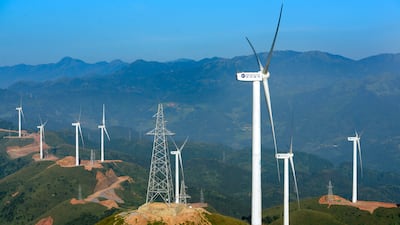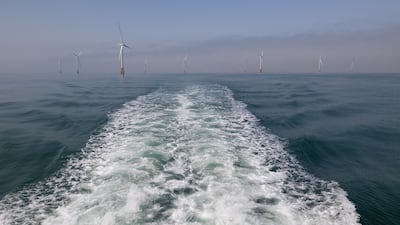Global wind turbine order intake surged by 27 per cent in the first three months of 2023, setting a record for the first quarter.
China, the world’s second-largest economy, accounted for nearly 65 per cent of the total order intake of 23.5 gigawatts, energy consultancy Wood Mackenzie said in a report.
In Latin America the level of activity increased to 1.7 gigawatts, while in the US order intake more than doubled to 1.8 gigawatts, surpassing the total for the first half of 2022.
In total, global orders hit an estimated $15.2 billion in the January to March period, up $3 billion from a year earlier, Wood Mackenzie said.
“China continues to be the overwhelming driver of global activity,” said Luke Lewandowski, research director at Wood Mackenzie.
“We do not see that slowing down anytime soon. What is encouraging is seeing certain areas outside of China start to build momentum.”
“Latin America had a record Q1, thanks to activity in Argentina and Brazil, and the US is seeing renewed confidence and order growth, partially in thanks to the Inflation Reduction Act.”
The IRA, enacted last year, offers a series of tax incentives on wind, solar, hydropower and other renewables, as well as a push towards electric vehicle ownership.
The move is expected to spur about $3 trillion of investment in renewable energy technology while doubling the amount of energy produced by the US shale revolution more than a decade ago, according to Goldman Sachs.
Wood Mackenzie said that while some areas outside China recorded growth, overall activity from western equipment manufacturers remained stagnant, with a 9 per cent year-on-year decline in first-quarter orders.
China is “pushing” growth strategies to meet local government renewable requirements, while western manufacturers are focusing on profitability, the consultancy said.
“Western OEMs [original equipment manufacturers] have remained very selective and disciplined in their activity, with the goal of improving their profitability,” said Mr Lewandowski.
“Pricing has remained relatively level in markets like the US, where strategies such as measured technology development and price indexing have been employed by western OEMs to expedite a return to profitability.”
Offshore wind orders fell by 12 per cent year-on-year, but Europe experienced growth, contributing three gigawatts of offshore activity, the report said.
In total, offshore wind represented 13 per cent of all orders in the first quarter.
Chinese green energy company Envision captured the largest share of new orders at 3.6 gigawatts, Wood Mackenzie said.
Danish wind turbine maker Vestas came in second with orders worth 3.3 gigawatts.
The global wind energy market will pass the one terawatt threshold for installed capacity by the end of 2023, Wood Mackenzie said in an April report.
Investment in clean energy is set to reach $1.7 trillion this year, outpacing spending on fossil fuels, as countries look to address potential energy shortages, the International Energy Agency said.
Global energy investments in 2023 are projected to reach $2.8 trillion, with more than 60 per cent allocated for clean technologies, including renewables, electric vehicles, nuclear power and heat pumps, the Paris-based agency said in its World Energy Investment report last week.
The remaining 40 per cent will be spent on coal, natural gas and crude oil, the report said.
UK’s AI plan
- AI ambassadors such as MIT economist Simon Johnson, Monzo cofounder Tom Blomfield and Google DeepMind’s Raia Hadsell
- £10bn AI growth zone in South Wales to create 5,000 jobs
- £100m of government support for startups building AI hardware products
- £250m to train new AI models
One in four Americans don't plan to retire
Nearly a quarter of Americans say they never plan to retire, according to a poll that suggests a disconnection between individuals' retirement plans and the realities of ageing in the workforce.
Experts say illness, injury, layoffs and caregiving responsibilities often force older workers to leave their jobs sooner than they'd like.
According to the poll from The Associated Press-NORC Centre for Public Affairs Research, 23 per cent of workers, including nearly two in 10 of those over 50, don't expect to stop working. Roughly another quarter of Americans say they will continue working beyond their 65th birthday.
According to government data, about one in five people 65 and older was working or actively looking for a job in June. The study surveyed 1,423 adults in February this year.
For many, money has a lot to do with the decision to keep working.
"The average retirement age that we see in the data has gone up a little bit, but it hasn't gone up that much," says Anqi Chen, assistant director of savings research at the Centre for Retirement Research at Boston College. "So people have to live in retirement much longer, and they may not have enough assets to support themselves in retirement."
When asked how financially comfortable they feel about retirement, 14 per cent of Americans under the age of 50 and 29 per cent over 50 say they feel extremely or very prepared, according to the poll. About another four in 10 older adults say they do feel somewhat prepared, while just about one-third feel unprepared.
"One of the things about thinking about never retiring is that you didn't save a whole lot of money," says Ronni Bennett, 78, who was pushed out of her job as a New York City-based website editor at 63.
She searched for work in the immediate aftermath of her layoff, a process she describes as akin to "banging my head against a wall." Finding Manhattan too expensive without a steady stream of income, she eventually moved to Portland, Maine. A few years later, she moved again, to Lake Oswego, Oregon. "Sometimes I fantasise that if I win the lottery, I'd go back to New York," says Ms Bennett.
Desert Warrior
Starring: Anthony Mackie, Aiysha Hart, Ben Kingsley
Director: Rupert Wyatt
Rating: 3/5
The five pillars of Islam
1. Fasting
2. Prayer
3. Hajj
4. Shahada
5. Zakat
Indian construction workers stranded in Ajman with unpaid dues
MATCH INFO
Uefa Champions League final:
Who: Real Madrid v Liverpool
Where: NSC Olimpiyskiy Stadium, Kiev, Ukraine
When: Saturday, May 26, 10.45pm (UAE)
TV: Match on BeIN Sports
Race card:
6.30pm: Baniyas (PA) Group 2 Dh195,000 1,400m.
7.05pm: Maiden (TB) Dh165,000 1,400m.
7.40pm: Handicap (TB) Dh190,000 1,200m.
8.15pm: Maiden (TB) Dh165,000 1,200m.
8.50pm: Rated Conditions (TB) Dh240,000 1,600m.
9.20pm: Handicap (TB) Dh165,000 1,400m.
10pm: Handicap (TB) Dh175,000 2,000m.
MATCH INFO
Norwich City 1 (Cantwell 75') Manchester United 2 (Aghalo 51' 118') After extra time.
Man of the match Harry Maguire (Manchester United)
England v South Africa schedule:
- First Test: At Lord's, England won by 219 runs
- Second Test: July 14-18, Trent Bridge, Nottingham, 2pm
- Third Test: The Oval, London, July 27-31, 2pm
- Fourth Test: Old Trafford, Manchester, August 4-8
The President's Cake
Director: Hasan Hadi
Starring: Baneen Ahmad Nayyef, Waheed Thabet Khreibat, Sajad Mohamad Qasem
Rating: 4/5
Race card
5pm: Handicap (PA) Dh80,000 (Turf) 1,600m; 5.30pm: Maiden (PA) Dh80,000 (T) 1,400m
6pm: Handicap (PA) Dh80,000 (T) 1,400m; 6.30pm: Handicap (PA) Dh80,000 (T) 1,200m
7pm: Wathba Stallions Cup Handicap (PA) Dh70,000 (T) 2,200m
7.30pm: Handicap (TB) Dh100,000 (PA) 1,400m
The Gentlemen
Director: Guy Ritchie
Stars: Colin Farrell, Hugh Grant
Three out of five stars
The%20specs
%3Cp%3E%3Cstrong%3EEngine%3A%3C%2Fstrong%3E%201.8-litre%204-cyl%20turbo%0D%3Cbr%3E%3Cstrong%3EPower%3A%20%3C%2Fstrong%3E190hp%20at%205%2C200rpm%0D%3Cbr%3E%3Cstrong%3ETorque%3A%3C%2Fstrong%3E%20320Nm%20from%201%2C800-5%2C000rpm%0D%3Cbr%3E%3Cstrong%3ETransmission%3A%20%3C%2Fstrong%3ESeven-speed%20dual-clutch%20auto%0D%3Cbr%3E%3Cstrong%3EFuel%20consumption%3A%3C%2Fstrong%3E%206.7L%2F100km%0D%3Cbr%3E%3Cstrong%3EPrice%3A%3C%2Fstrong%3E%20From%20Dh111%2C195%0D%3Cbr%3E%3Cstrong%3EOn%20sale%3A%20%3C%2Fstrong%3ENow%3C%2Fp%3E%0A
COMPANY PROFILE
Name: Kumulus Water
Started: 2021
Founders: Iheb Triki and Mohamed Ali Abid
Based: Tunisia
Sector: Water technology
Number of staff: 22
Investment raised: $4 million
The stats
Ship name: MSC Bellissima
Ship class: Meraviglia Class
Delivery date: February 27, 2019
Gross tonnage: 171,598 GT
Passenger capacity: 5,686
Crew members: 1,536
Number of cabins: 2,217
Length: 315.3 metres
Maximum speed: 22.7 knots (42kph)
Key recommendations
- Fewer criminals put behind bars and more to serve sentences in the community, with short sentences scrapped and many inmates released earlier.
- Greater use of curfews and exclusion zones to deliver tougher supervision than ever on criminals.
- Explore wider powers for judges to punish offenders by blocking them from attending football matches, banning them from driving or travelling abroad through an expansion of ‘ancillary orders’.
- More Intensive Supervision Courts to tackle the root causes of crime such as alcohol and drug abuse – forcing repeat offenders to take part in tough treatment programmes or face prison.
Boston%20Strangler
%3Cp%3E%3Cstrong%3EDirector%3A%3C%2Fstrong%3E%20Matt%20Ruskin%3Cbr%3E%3Cstrong%3EStarring%3A%20%3C%2Fstrong%3EKeira%20Knightley%2C%20Carrie%20Coon%2C%20Alessandro%20Nivola%3Cbr%3E%3Cstrong%3ERating%3A%3C%2Fstrong%3E%203%2F5%3Cbr%3E%3C%2Fp%3E%0A
RACE CARD
6.30pm Maiden (TB) Dh82.500 (Dirt) 1,400m
7.05pm Handicap (TB) Dh87,500 (D) 1,400m
7.40pm Handicap (TB) Dh92,500 (Turf) 2,410m
8.15pm Handicap (TB) Dh105,000 (D) 1,900m
8.50pm UAE 2000 Guineas Trial (TB) Conditions Dh183,650 (D) 1,600m
9.25pm Dubai Trophy (TB) Conditions Dh183,650 (T) 1,200m
10pm Handicap (TB) Dh102,500 (T) 1,400m
Avatar: Fire and Ash
Director: James Cameron
Starring: Sam Worthington, Sigourney Weaver, Zoe Saldana
Rating: 4.5/5
'Shakuntala Devi'
Starring: Vidya Balan, Sanya Malhotra
Director: Anu Menon
Rating: Three out of five stars
The specs
- Engine: 3.9-litre twin-turbo V8
- Power: 640hp
- Torque: 760nm
- On sale: 2026
- Price: Not announced yet
Specs
Engine: Duel electric motors
Power: 659hp
Torque: 1075Nm
On sale: Available for pre-order now
Price: On request
German intelligence warnings
- 2002: "Hezbollah supporters feared becoming a target of security services because of the effects of [9/11] ... discussions on Hezbollah policy moved from mosques into smaller circles in private homes." Supporters in Germany: 800
- 2013: "Financial and logistical support from Germany for Hezbollah in Lebanon supports the armed struggle against Israel ... Hezbollah supporters in Germany hold back from actions that would gain publicity." Supporters in Germany: 950
- 2023: "It must be reckoned with that Hezbollah will continue to plan terrorist actions outside the Middle East against Israel or Israeli interests." Supporters in Germany: 1,250
Source: Federal Office for the Protection of the Constitution
ASIAN%20RUGBY%20CHAMPIONSHIP%202024
%3Cp%3E%3Cstrong%3EResults%3C%2Fstrong%3E%3Cbr%3EHong%20Kong%2052-5%20UAE%3Cbr%3ESouth%20Korea%2055-5%20Malaysia%3Cbr%3EMalaysia%206-70%20Hong%20Kong%3Cbr%3EUAE%2036-32%20South%20Korea%3Cbr%3E%3Cbr%3E%3Cstrong%3EFixtures%3C%2Fstrong%3E%3Cbr%3EFriday%2C%20June%2021%2C%207.30pm%20kick-off%3A%20UAE%20v%20Malaysia%3Cbr%3EAt%20The%20Sevens%2C%20Dubai%20(admission%20is%20free).%3Cbr%3ESaturday%3A%20Hong%20Kong%20v%20South%20Korea%3Cbr%3E%3C%2Fp%3E%0A
Company%C2%A0profile
%3Cp%3E%3Cstrong%3EName%3A%20%3C%2Fstrong%3EPyppl%3C%2Fp%3E%0A%3Cp%3E%3Cstrong%3EEstablished%3A%20%3C%2Fstrong%3E2017%3C%2Fp%3E%0A%3Cp%3E%3Cstrong%3EFounders%3A%20%3C%2Fstrong%3EAntti%20Arponen%20and%20Phil%20Reynolds%26nbsp%3B%3C%2Fp%3E%0A%3Cp%3E%3Cstrong%3EBased%3A%3C%2Fstrong%3E%20UAE%3C%2Fp%3E%0A%3Cp%3E%3Cstrong%3ESector%3A%3C%2Fstrong%3E%20financial%20services%3C%2Fp%3E%0A%3Cp%3E%3Cstrong%3EInvestment%3A%3C%2Fstrong%3E%20%2418.5%20million%3C%2Fp%3E%0A%3Cp%3E%3Cstrong%3EEmployees%3A%3C%2Fstrong%3E%20150%3C%2Fp%3E%0A%3Cp%3E%3Cstrong%3EFunding%20stage%3A%3C%2Fstrong%3E%20series%20A%2C%20closed%20in%202021%3C%2Fp%3E%0A%3Cp%3E%3Cstrong%3EInvestors%3A%3C%2Fstrong%3E%20venture%20capital%20companies%2C%20international%20funds%2C%20family%20offices%2C%20high-net-worth%20individuals%3C%2Fp%3E%0A








